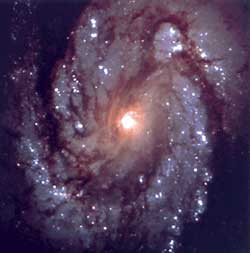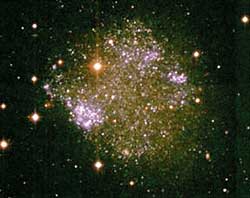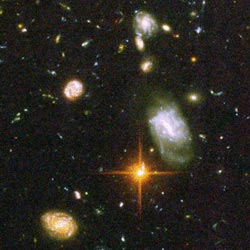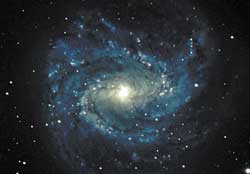World Book at NASA
 |
|
A spiral galaxy resembles a pinwheel, with spiral arms coiling out from a central bulge. This galaxy, known as M100, looks much like our home galaxy, the Milky Way. However, the Milky Way has a bar of stars, dust, and gas across its center. Image credit: D. Hunter (Lowell Observatory) and Z. Levay (Space Telescope Science Institute)/NASA |
Only three galaxies outside the Milky Way are visible with the unaided eye. People in the Northern Hemisphere can see the Andromeda Galaxy, which is about 2 million light-years away. People in the Southern Hemisphere can see the Large Magellanic Cloud, which is about 160,000 light-years from Earth, and the Small Magellanic Cloud, which is about 180,000 light-years away.
Groups of galaxies
Galaxies are distributed unevenly in space. Some have no close neighbor. Others occur in pairs, with each orbiting the other. But most of them are found in groups called clusters. A cluster may contain from a few dozen to several thousand galaxies. It may have a diameter as large as 10 million light-years.
Clusters of galaxies, in turn, are grouped in larger structures called superclusters. On even larger scales, galaxies are arranged in huge networks. The networks consist of interconnected strings or filaments of galaxies surrounding relatively empty regions known as voids. One of the largest structures ever mapped is a network of galaxies known as the Great Wall. This structure is more than 500 million light-years long and 200 million light-years wide.
Shapes of galaxies
 |
|
A globular cluster is a tightly grouped swarm of stars held together by gravity. This globular cluster is one of the densest of the 147 known clusters in the Milky Way galaxy. Image credit: NASA |
New stars are constantly forming out of gas and dust in spiral galaxies. Smaller groups of stars called globular clusters often surround spiral galaxies. A typical globular cluster has about 1 million stars.
Elliptical galaxies range in shape from almost perfect spheres to flattened globes. The light from an elliptical galaxy is brightest in the center and gradually becomes fainter toward its outer regions. As far as astronomers can determine, elliptical galaxies rotate much more slowly than spiral galaxies or not at all. The stars within them appear to move in random orbits. Elliptical galaxies have much less dust and gas than spiral galaxies have, and few new stars appear to be forming in them.
 |
|
An irregular galaxy, Sextans A does not have a simple shape like a spiral or elliptical galaxy. The bright, yellowish stars in the foreground are part of the Milky Way, Earth's "home" galaxy. Image credit: NASA |
Galaxies move relative to one another, and occasionally two galaxies come so close to each other that the gravitational force of each changes the shape of the other. Galaxies can even collide. If two rapidly moving galaxies collide, they may pass right through each other with little or no effect. However, when slow-moving galaxies collide, they can merge into a single galaxy that is bigger than either of the original galaxies. Such mergers can produce spiral filaments of stars that can extend more than 100,000 light-years into space.
Emissions from galaxies
 |
|
An image taken in 2001 with the Hubble Space Telescope reveals the irregular-shaped galaxy ESO 510-13, which astronomers theorize is twisted because of gravitational effects that occurred when it absorbed a smaller galaxy. Image credit: NASA and Hubble Heritage Team |
The energy emitted by galaxies comes from various sources. Much of it is due to the heat of the stars and of clouds of dust and gas called nebulae. A variety of violent events also provide a great deal of the energy. These events include two kinds of stellar explosions: (1) nova explosions, in which one of the two members of a binary star system hurls dust and gas into space; (2) much more violent supernova explosions, in which a star collapses, then throws off most of its matter. One supernova may leave behind a compact, invisible object called a black hole, which has such powerful gravitational force that not even light can escape it. Another supernova may leave behind a neutron star, which consists mostly of tightly packed neutrons, particles that ordinarily occur only in the nuclei of atoms. But some supernovae leave nothing behind.
 |
|
The most distant galaxies yet observed appear as faint patches of light in this photograph taken by the Hubble Space Telescope. The brighter swirls are galaxies somewhat closer to Earth, and the bright orange object is a star in our own galaxy. The telescope photographed this tiny portion of the sky, called the Hubble Ultra Deep Field, in 2004. Image credit: NASA/ESA/S. Beckwith (STScl) and the HUDF Team |
A small percentage of galaxies called active galaxies emit tremendous amounts of energy. This energy results from violent events occurring in objects at their center. The distribution of the wavelengths of the emissions does not resemble that of normal stars, and so the emissions are known as nonthermal radiation. The most powerful such object is a quasar, which emits a huge amount of radio, infrared, ultraviolet, X-ray, and gamma-ray energy. Some quasars emit 1,000 times as much energy as the entire Milky Way, yet look like stars in photographs. Quasar is short for quasi-stellar radio source. The name comes from the fact that the first quasars identified emit mostly radio energy and look much like stars. A radio galaxy is related to, but appears larger than, a quasar.
A Seyfert galaxy is a spiral galaxy that emits large amounts of infrared rays as well as large amounts of radio waves, X rays, or both radio waves and X rays. Seyfert galaxies get their name from American astronomer Carl K. Seyfert, who in 1943 became the first person to discover one.
Some active galaxies emit jets and blobs of highly energetic, electrically charged particles. These particles include positively charged protons and positrons and negatively charged electrons. Electrons and protons are forms of ordinary matter, but positrons are antimatter particles. They are the antimatter opposites of electrons -- that is, they have the same mass (amount of matter) as electrons, but they carry the opposite charge. See Antimatter.
The cause of the intense activity in active galaxies is thought to arise from a colossal black hole at the galactic center. The black hole can be as much as a billion times as massive as the sun. Because the black hole is so massive and compact, its gravitational force is powerful enough to tear apart nearby stars. The resulting dust and gas fall toward the black hole, adding their mass to a disk of matter called an accretion disk that orbits the black hole. At the same time, matter from the inner edge of the disk falls into the black hole. As the matter falls, it loses energy, thereby producing the radiation and jets that shoot out of the galaxy.
 |
|
Galaxy M83 The galaxy M83 is shaped much like our home galaxy, the Milky Way. The diameter of the Milky Way is approximately 100,000 light-years -- roughly 700 billion times the sun's diameter. Image credit: noAO/AURA/NSF |
Origin of galaxies
Scientists have proposed two main kinds of theories of the origin of galaxies: (1) bottom-up theories and (2) top-down theories. The starting point for both kinds of theories is the big bang, the explosion with which the universe began 10 billion to 20 billion years ago. Shortly after the big bang, masses of gas began to gather together or collapse. Gravity then slowly compressed these masses into galaxies.
The two kinds of theories differ concerning how the galaxies evolved. Bottom-up theories state that much smaller objects such as globular clusters formed first. These objects then merged to form galaxies. According to top-down theories, large objects such as galaxies and clusters of galaxies formed first. The smaller groups of stars then formed within them. But all big bang theories of galaxy formation agree that no new galaxies -- or very few -- have formed since the earliest times.
Astronomers have found evidence of what conditions were like before the galaxies formed. In 1965, American physicists Arno Penzias and Robert Wilson detected faint radio waves throughout the sky. According to the big bang theory, the waves are radiation left over from the initial explosion. The strength of the radio waves appeared to be very nearly the same in every direction. But in 1992, a satellite called the Cosmic Background Explorer (COBE) detected tiny differences in the strength of radio waves coming from different directions. The differences in strength arise from tiny increases in the density of matter in the universe shortly after the big bang. The small regions of increased density had a stronger gravitational force than the surrounding matter. Clumps of matter therefore formed in these regions; and the clumps eventually collapsed into galaxies.
Most astronomical observations made to date support big bang theories. According to these theories, the universe is still expanding. Two kinds of observations strongly support the idea of an expanding universe. These observations indicate that all galaxies are moving away from one another and that the galaxies farthest from the Milky Way are moving away most rapidly. This relationship between speed and distance is known as the Hubble law of recession (moving backward), or Hubble's law. The law was named after American astronomer Edwin P. Hubble, who reported it in 1929.
 |
|
Redshift causes a displacement of lines in the spectrum (band of colors) sent out by a galaxy that is moving away from Earth. If the galaxy were motionless relative to Earth, those lines would appear in the positions shown in the upper diagram. The cause of the displacement is known as redshift because the lines are displaced toward the red end of the spectrum. Image credit: World Book diagram by Ernest Norcia |
Scientists estimate the distance to galaxies by measuring the galaxies' overall brightness or the brightness of certain kinds of objects within them. These objects include variable stars as well as supernovae.
Evolution of spiral galaxies
Astronomers do not understand clearly how galactic spirals evolved and why they still exist. The mystery arises when one considers how a spiral galaxy rotates. The galaxy spins much like the cream on the surface of a cup of coffee. The inner part of the galaxy rotates somewhat like a solid wheel, and the arms trail behind. Suppose a spiral arm rotated around the center of its galaxy in about 250 million years -- as in the Milky Way. After a few rotations, taking perhaps 2 billion years, the arms would "wind up," producing a fairly continuous mass of stars. But almost all spiral galaxies are much older than 2 billion years.
According to one proposed solution to the mystery, differences in gravitational
force throughout the galaxy push and pull at the stars, dust, and gas. This
activity produces waves of compression. A familiar example of waves of compression
are ordinary sound waves. Because the galaxy is rotating, the waves seem to
travel in a spiral path, leading to the appearance of spiral arms of dense dust
and gas. Stars then form in the arms.
Contributor: Kenneth Brecher, Ph.D., Professor of Astronomy and Physics, Boston University.
How to cite this article:
To cite this article, World Book recommends the following format:
Brecher, Kenneth. "Galaxy." World Book Online Reference Center. 2005. World Book, Inc. http://www.worldbookonline.com/wb/Article?id=ar215080.
| › Return to Topics | › Back to Top |